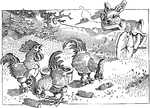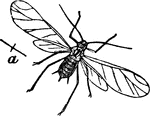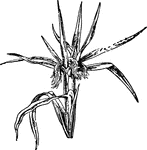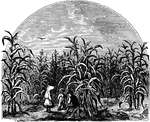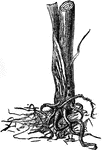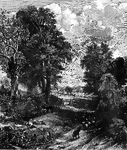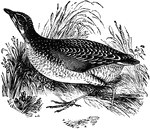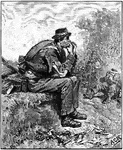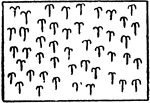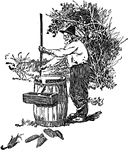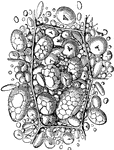
Corn Stem
This illustration shows the cross-section of a single vascular bundle of corn stem: ph, phloem; x, small…

Quern
"A primitive mill for grinding corn, the stone of which was turned by the hand before the invention…

Beni Hassan
"Among the figures painted in the very ancient tomb at Beni Hassan, in Egypt, occurs a group of figures…

Corn Beetle
"Corn Beetle: a, larva, natural size; b, larva, magnified; c, perfect insect, natural dize; d, perfect…
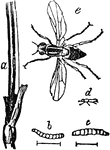
Corn Fly
"Corn Fly (Chlorops taeniopus): a, a portion of a culm or stem of wheat with swollen joint, caused by…
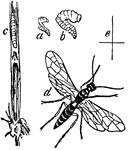
Corn Sawfly
"Corn Sawfly: a, maggot, natural size; b, maggot, magnified; c, the maggot in its ear in the stem of…
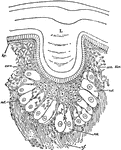
Limulus
"Section through one of the central eyes of a young Limulus. L, Cuticular or corneous lens. hy, Epidermic…
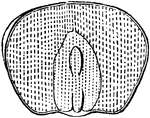
Indian Corn Grain
A grain of Indian Corn, flatwise, cut away a little, so as to show the embryo, lying on the albumen,…

Indian Corn Embryo
The embryo, taken out whole: the thick mass is the cotyledon; the narrow body partly enclosed by it…
Indian Corn Grain
Grain of Indian Corn in germination; the ascending sprout is the first leaf of the plumule, enclosing…

Indian Corn Grain
Grain of Indian Corn in advanced germination; the second and third leaves developing, while the sheathing…

John Bright
(1811-1889) British radical and Liberal statesman, known for the formation of the Anti-Corn Law League…

Copper-Nickel Five Cent Coin, 1883
Five Cent (5 cent) United States coin from 1883. Obverse has a left-facing profile of Liberty wearing…
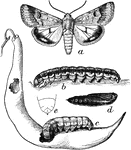
Boll Worm Stages
"Heliothis armiger: a moth; b, dark larva; c, lighter larva entering pod; d, pupa; e, last segment of…

Broom-Corn Millet
"Broom-corn Millet: a, b, and c, views of the spikelet and glumes, or chaff; d and e, two views of the…
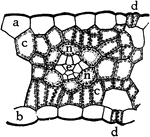
Indian Corn Leaf Cells
"Cross section of a portion of a leaf of Indian corn. a, upper and b, lower epidermis; c, c, palisade…

Indian Corn Food Circulation
"Diagram showing how, in Indian corn, the food from the upper and lower leaves finds its way into the…
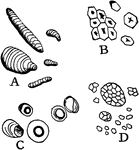
Starch
"Starch from different sources. A, curcuma starch; B, corn starch; C, tapioca starch; D, rice starch,…

Pale Corydalis and Squirrel Corn
Of the fumitory family (Fumariaceae): left, pale corydalis (Corydalis sempervirens); right, squirrel…

Valerianella Woodsiana
Of the Valerian family (Valerianaceae), the corn salad (Valerianella Woodsiana).
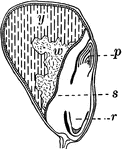
Corn Grain
"Lengthwise section of grain of corn. y, yellow, oily part of endosperm; w, white, starchy part of endosperm;…
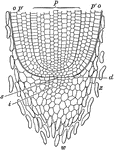
Corn Root Tip
"Lengthwise section through root-tip of Indian corn. w, root-cap; i, younger part of cap; z, dead cells…
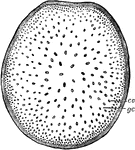
Corn Section
"Diagrammatic cross-section of stem of Indian corn. cv, fibro-vascular bundles; gc, pithy material between…
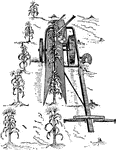
Cutting Mechanism of Corn-Harvester
This machine cuts the corn and binds the stalks in bundles ready for shocking.
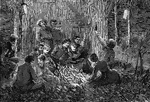
Group Shucking Corn
An illustration of a group of people sitting in a barn surrounded by corn while shucking fresh ears…
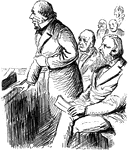
Benjamin Disraeli
Benjamin Disraeli, 1st Earl of Beaconsfield, (21 December 1804 – 19 April 1881), was a British Conservative…

Seed-Corn Maggot
"Seed-corn Maggot (Phorbia fusciceps). a, maggot; b, pupa. Kernels of Maize, showing work of the maggot."…

Benjamin Disraeli
Benjamin Disraeli, 1st Earl of Beaconsfield, KG, PC, FRS, born Benjamin D'Israeli, (21 December 1804…
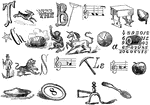
Food Rebus
"There were on the breakfast table only a cornstarch pudding, a puny corn-ball, a muffin, some dandelions,…
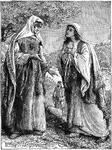
Ruth and Naomi
"And Ruth the Moabitess said unto Naomi, Let me now go to the field, and glean ears of corn after him…
Meadow Brome Grass
The Meadow Brome Grass (Bromus pratensis) is a perennial weed in the corn-fields of England, and is…
Meadow Brome Grass
The Meadow Brome Grass (Bromus pratensis) is a perennial weed in the corn-fields of England, and is…

Chinese Sugar Cane
The stem of Chinese Sugar Cane (Sorghum nigrum), also known as Sorgho, or Sorgho Sucre, rises from six…

